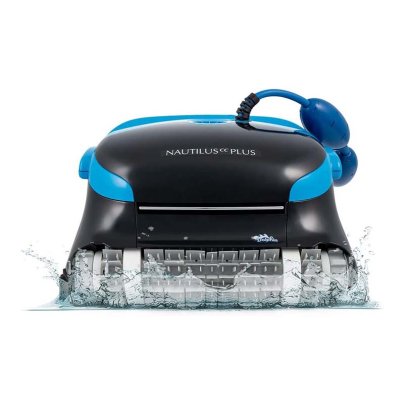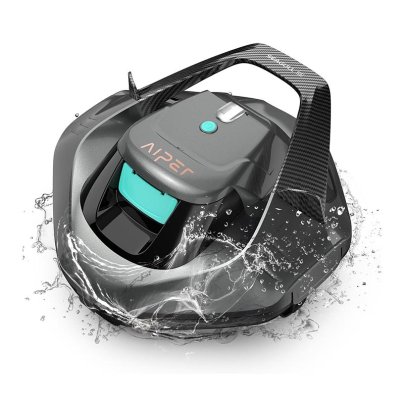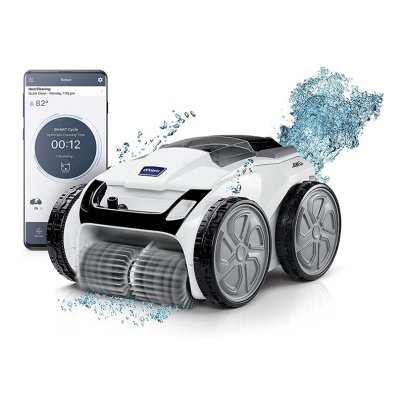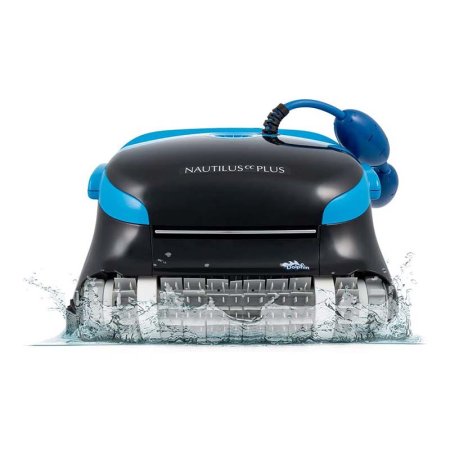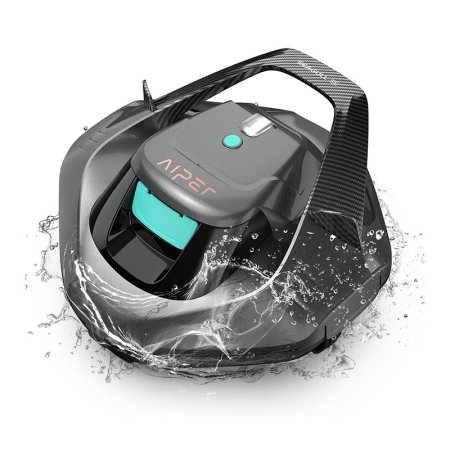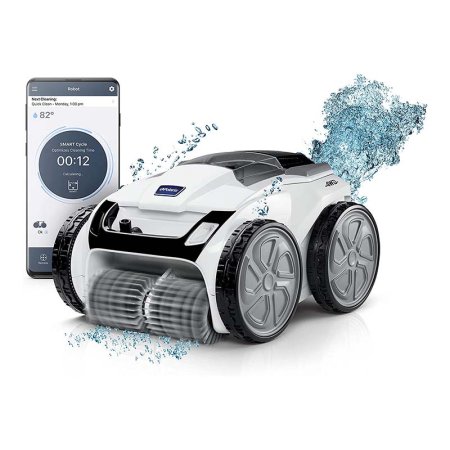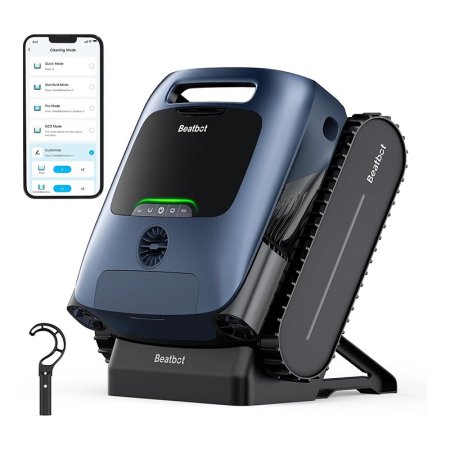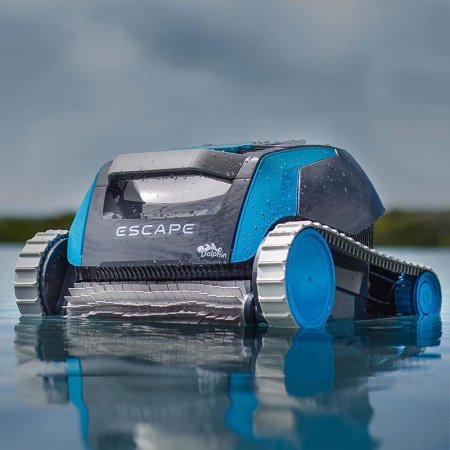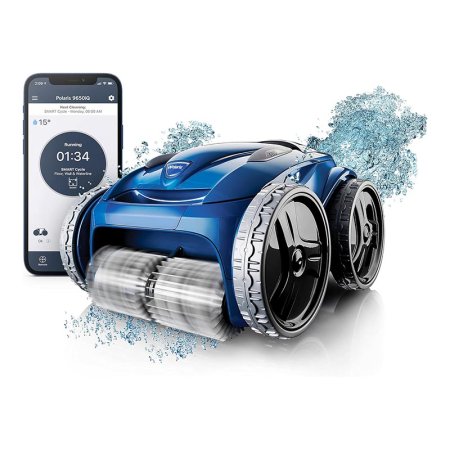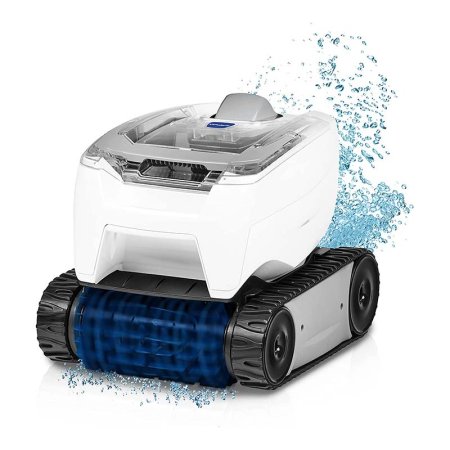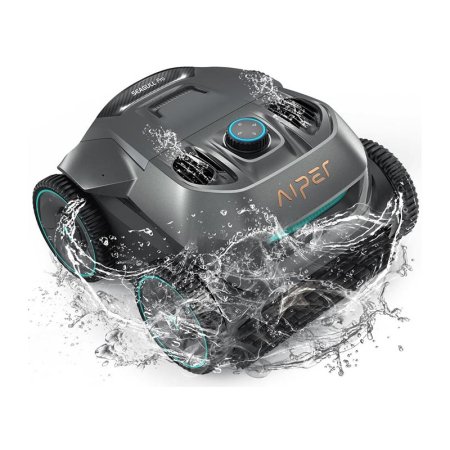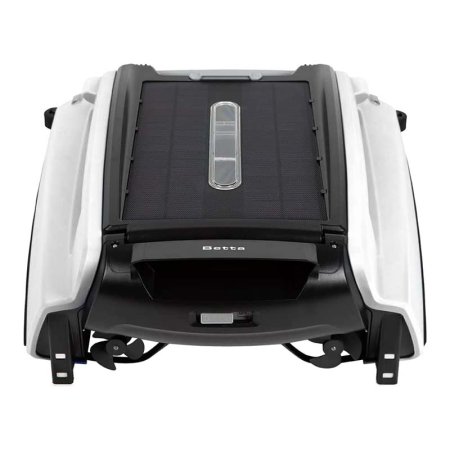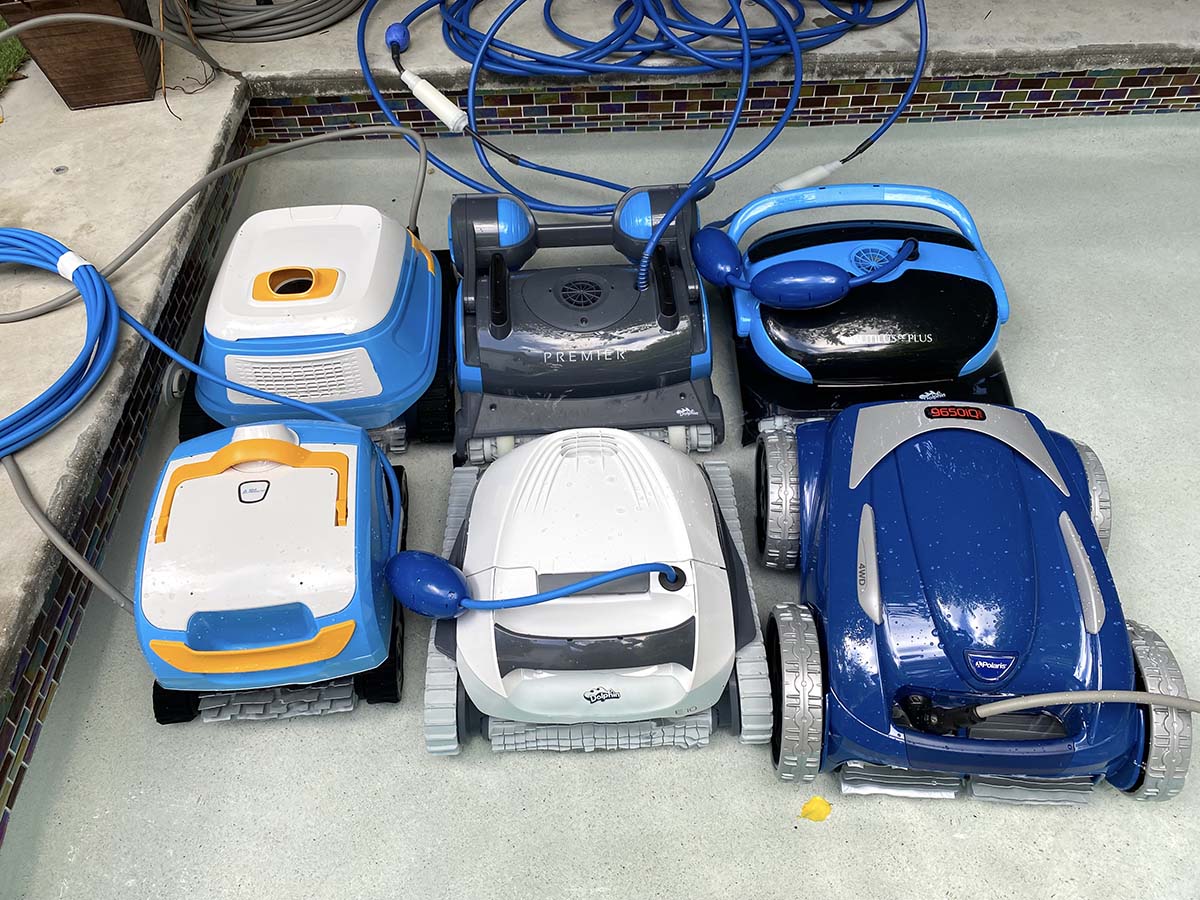
We may earn revenue from the products available on this page and participate in affiliate programs. Learn More ›
Few people enjoy vacuuming their swimming pool, but a robotic pool cleaner may be just the trick for this important maintenance task that limits the growth of algae and allows the chemicals in the water to work more efficiently. The best automatic pool cleaners operate much like robotic cleaners for the home, allowing you to set up sensor boundaries and choose the cleaning cycle.
We interviewed pool experts to get their advice and then tested the following robotic pool cleaners in both above-ground and inground pools in real-life conditions, and we used them in both chlorine- and salt-based systems. Our favorite was the Nautilus CC Plus Robotic Pool Cleaner from Dolphin, which can climb walls and collect large debris in its impressive filtration system while the Betta SE Solar-Powered Smart Robotic Pool Skimmer came in as our favorite robotic skimmer.
In addition to our top pick, consider our comprehensive list of the best robotic pool cleaners below to find the one that will work best for your swimming pool.
- BEST OVERALL: Dolphin Nautilus CC Plus Robotic Pool Cleaner
↓ Jump to Review - BEST BANG FOR THE BUCK: Aiper Seagull SE Robotic Pool Cleaner
↓ Jump to Review - UPGRADE PICK: Polaris VRX iQ+ Smart Robotic Pool Cleaner
↓ Jump to Review - BEST ALL-IN-ONE: Beatbot AquaSense Pro Cordless Robotic Pool Cleaner
↓ Jump to Review - BEST FOR ABOVE-GROUND: Dolphin Escape Robotic Pool Cleaner
↓ Jump to Review - BEST FOR INGROUND: Polaris 9650iQ Sport Robotic Pool Cleaner
↓ Jump to Review - BEST FOR SMALLER POOLS: Polaris P70 Robotic Pool Cleaner
↓ Jump to Review - BEST CORDLESS: Aiper Seagull Pro Robotic Pool Cleaner
↓ Jump to Review - BEST ROBOTIC SKIMMER: Betta SE Solar-Powered Smart Robotic Pool Skimmer
↓ Jump to Review
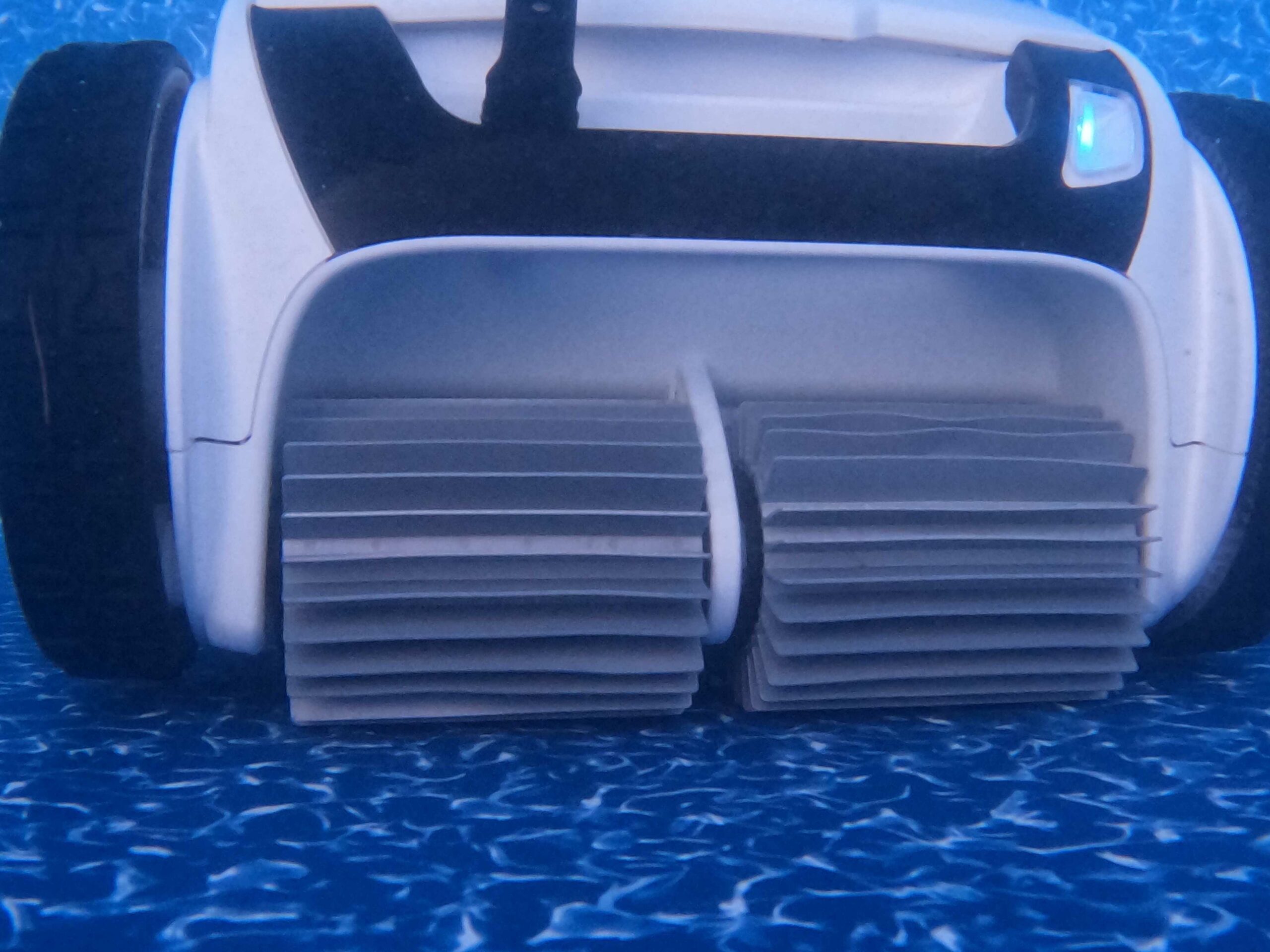
| Testing Stats | |
| Products tested | 17 |
| Time spent testing | 2 months |
| Tests performed | 4 to 5 |
| Price range | $300 to $2,100 |
Our Top Picks
The best pool cleaner robots listed below were chosen based on the criteria mentioned above in addition to quality, price, and customer satisfaction to help you find the right model for your pool.
Best Overall
Dolphin Nautilus CC Plus Robotic Pool Cleaner
What We Like
- Capable of climbing walls for a more thorough cleaning
- Large filtration system is suitable for sticks and leaves
- Can be used on all pool-surface types
- Users can schedule cleaning weekly
What We Don’t Like
- Does not have smartphone capabilities
- May become stuck on steps and require assistance
- Power supply is water-resistant but not waterproof
Product Specs
- Pool type: Inground
- Cable length: 60 feet
- Cleaning time: 2 hours
Our Ratings: Ease of Use 4/5; Suction 5/5; Performance 4.5/5; Ease of Cleaning 5/5; Value 5/5
The Dolphin Nautilus CC Plus robotic pool cleaner uses dual scrubbing brushes and a large filtration system to clean and collect leaves, twigs, dirt, pollen, and other debris in just about 2 hours. Schedule the automatic pool cleaner to run every day, every other day, or every third day.
That said, we didn’t want to keep this (or any) robotic pool cleaner in the pool without a caddy to hold the excess cable, as we have dogs to chase around the yard and could easily trip over the cables. Additionally, the power supply is not waterproof but rather water-resistant. We were interrupted by a thunderstorm halfway through the 2-hour cleaning cycle and didn’t feel comfortable leaving the unit outside to get completely soaked. A cover is available, although it’s sold separately.
On a separate note, the robotic cleaner has wall-climbing capabilities to clean inground swimming pools up to 50 feet in length. We love how the pool cleaner reverses itself at the top of walls. It actively scrubs with strong suction, sucking up all kinds of debris like a bottom-feeding fish. We also really like that this cleaner can be used on all types of pool floors without issue and has a tangle-free swivel cable to let it freely circulate, which it will do even while swimmers are in the water.
Get the Dolphin Nautilus pool cleaning robot at Amazon, Walmart, or Pool Warehouse.
Best Bang for the Buck
Aiper Seagull SE Robotic Pool Cleaner
What We Like
- Cordless design prevents anything from becoming tangled in the cord
- 90-minute runtime is plenty to clean an above-ground or flat inground pool
- Easy to clean and maintain
- Lightweight compared to some of the larger robot vacuums
What We Don’t Like
- No debris basket to catch leaves, twigs, and other debris.
- Not designed for pools with a slope
Product Specs
- Pool type: Above-ground or flat inground
- Cable length: N/A (cordless)
- Cleaning time: 90 minutes on a single charge
Our Ratings: Ease of Use 5/5; Suction 4/5; Performance 4/5; Ease of Cleaning 5/5; Value 5/5
We really love the Aiper Seagull SE robotic pool cleaner as an entry-level and affordable pick. While a bit smaller than most on this list, the Seagull SE is ideal for above-ground pools or smaller inground pools. We found the robot to be quick and efficient with its cleaning cycle.
The Seagull doesn’t have a dedicated debris basket, so you have to hose down the unit after use. It also requires recharging, but we found this to be one of the quicker robots to charge in just under 3 hours. It runs for a total of 90 minutes, which was plenty of time to clear our pool of dirt and debris.
This robot is a powerful and affordable option to take the manual work out of cleaning a pool. It’s important to know that this smaller unit may not handle large amounts of leaves or pieces of debris.
Get the Aiper Seagull SE robotic pool cleaner at Amazon or Aiper.
Upgrade Pick
Polaris VRX iQ+ Smart Robotic Pool Cleaner
What We Like
- Handles walls, stairs, and bench seats with ease
- 4-wheel drive for improved control and stability
- Wi-Fi and Amazon Alexa compatible with iAquaLink app
- Caddy included for easy storage
- Dirty-canister indicator alerts users when ready to be emptied
What We Don’t Like
- High price compared to some other models on the market
- Caddy cover is not included but can be purchased separately
Product Specs
- Pool type: Inground, or above-ground by choosing floor-only mode
- Cable length: 70 feet
- Cleaning time: Customizable
Our Ratings: Ease of Use 5/5; Suction 5/5; Performance 5/5; Ease of Cleaning 5/5; Value 3.5/5
As long as the premium price doesn’t hurt your wallet too much, this high-quality robotic pool vacuum by Polaris is easily one of the top products on the market for suction, propulsion, efficiency, and user control. Not only can the pool cleaner climb the walls and sense the top, it also goes up and down steps and bench seats without an issue. This is due to the four-wheel drive system that improves the traction, control, and stability of the device.
The robotic cleaner is Wi-Fi compatible, allowing users to connect directly to the vacuum through the iAquaLink app on their smartphone or through Amazon Alexa. The app features plenty of customization options and provides a temperature display.
The pool cleaner has a 70-foot power cable, so it is suitable for pools up to 60 feet. Pool owners can customize the cleaning time to their preference, which we found to be a great option. Sometimes only a little touch-up is needed and there’s no need for a whole cycle run-through.
Since the Polaris has seven cleaning modes, it’s easy to find one for every occasion. Another great feature is the ability to quickly choose floor only, floor and walls, or waterline cleaning right from the power-control box. It was so intuitive, the kids could even get it started with ease.
We really liked that this unit has a dirty-canister indicator so that the vacuum can be emptied and cleaned when necessary. However, our favorite feature is the ability to return the unit to the top of the water. This eliminates the need to fish it out of the pool with a pole or tug on the electrical cord. All that’s required is to simply press the button and the unit climbs the wall and returns to the top of the pool for easy retrieval.
Get the Polaris VRX iQ+ robotic pool cleaner at Amazon or Leslie’s.
Best All-in-One
Beatbot AquaSense Pro Cordless Robotic Pool Cleaner
What We Like
- Can skim the waterline to serve as a skimmer
- Cord-free design
- Recharges in under 5 hours
- All-in-one design allows for a whole-pool clean using 1 unit
What We Don’t Like
- Requires recharging
- If stopped mid cycle, the robot must be retrieved with the included hook
Product Specs
- Pool type: Above-ground or inground
- Cable length: Cordless
- Cleaning time: 90 minutes
Our Ratings: Ease of Use 4/5; Suction 5/5; Performance 5/5; Ease of Cleaning 5/5; Value 4/5
When we saw a pool robot being introduced that claimed to be the world’s first five-in-one intelligent robot, we had to give it a try. We’ve tested a lot of robotic pool cleaners, and we’ve been impressed with this robot since unboxing. It has a sleek design and is paired with an easy-to-use app. Once charged, we placed it in the pool to see what it could handle.
The robot has 20 smart sensors and utilizes AI algorithms to ensure the most efficient cleaning path. It was neat to watch the robot scan the bottom of our pool and create a path forward. The cleaning took under 60 minutes for our above-ground pool. Once finished, the BeatBot robot used its SmartPark feature to climb the wall and park at the surface of the pool.
Perhaps our favorite feature is the SmartDrain technology the robot uses as a water-release system. This makes the robot lighter and easier to retrieve. A big downfall of most robotic cleaners is how heavy they are, making them difficult to remove from various pool types. The BeatBot tackles that problem with this draining mechanism.
Overall, the BeatBot is an incredibly impressive robot and is one of the best we’ve tested. It’s a bit expensive, but if you can grab it while it’s on sale, it’s worth the investment.
Get the Beatbot robotic pool cleaner at Amazon or Beatbot.
Best for above-Ground
Dolphin Escape Robotic Pool Cleaner
What We Like
- Quick 90-minute cleaning cycle lets pool users enjoy a clean pool faster
- Comes with a convenient remote-start function
- Can be used on all pool surface types, including gunite or plaster pools
What We Don’t Like
- Cannot climb pool walls
- Electrical adapter is not waterproof
- Difficult to remove from the pool if it stops mid-cycle
Product Specs
- Pool type: Above-ground or inground
- Cable length: 40 feet
- Cleaning time: 90 minutes
Our Ratings: Ease of Use 4/5; Suction 5/5; Performance 4/5; Ease of Cleaning 4/5; Value 4.5/5
Many robotic pool cleaners don’t work on above-ground pools, but the Dolphin Escape robotic pool cleaner is designed specifically for this type of pool. Although this robotic pool cleaner does not climb walls, it cleans pool floors made from gunite/plaster, vinyl, and fiberglass in pools up to 30 feet in length.
The machine has dual scrubbing brushes, and the large-capacity filter traps all sizes of debris during the 90-minute cleaning cycle.
The Dolphin Escape was extremely easy to set up, and it was up and running in less than 5 minutes. To activate the 90-minute cleaning cycle, all that’s required is to simply push the button on the power adapter. The button will then light up blue to indicate the vacuum is cleaning. Once the cycle is finished, the vacuum stops and the light turns off. This unit is also electrical, which means there’s no waiting for it to recharge.
Keep in mind that the power adapter is not waterproof, so it cannot be submerged or left out in the rain. When testing, we were able to easily set it on our pool filter or pool deck.
The only downfall we found for this unit was the difficulty we had when taking it out of the pool. The vacuum stops after the 90-minute cycle, which means it sometimes stops in the middle of the pool. Owners can gently tug on the power cord to pull the unit toward them and then lift it out of the pool. It is quite heavy when it’s full of water, though, so to pull it onto the deck or over the pool wall, we had to allow it to drain first.
Read our full review: Dolphin Escape Robotic Pool Cleaner
Get the Dolphin Escape robotic pool cleaner at Amazon.
Best for Inground
Polaris 9650iQ Sport Robotic Pool Cleaner
What We Like
- Handles walls, stairs, and bench seats with ease
- Wi-Fi and Amazon Alexa compatible
- Comes with a caddy at no extra cost
- Dirty-canister indicator tells you when to empty
- 4-wheel drive improves control and stability
What We Don’t Like
- Premium price tag compared to similar options
- Caddy cover is not included (purchased separately)
Product Specs
- Pool type: Inground
- Cable length: 70 feet
- Cleaning time: Customizable
Our Ratings: Ease of Use 5/5; Suction 5/5; Performance 5/5; Ease of Cleaning 5/5; Value 3/5
The Polaris 9650iQ Sport offers scheduled and timed cleaning. This robotic cleaner is Wi-Fi compatible, allowing users to control and monitor the vacuum through Polaris’ iAquaLink app. Alexa is a better option if swimmers are using the pool at the same time, given that phones tend to overheat and/or don’t like getting wet.
We liked that we were able to choose how long we wanted the vacuum to operate and which cleaning mode to use. When the pool was dirty and had more debris after a storm, it made sense to have the robot run longer and use the deep-clean cleaning mode.
Thanks to its four-wheel drive feature, it’s able to climb over obstacles without getting stuck, which we found to be useful when the kids forgot a large sinking toy in the pool.
It’s a good idea to pay attention to the dirty-canister indicator so that the vacuum can be emptied and cleaned when necessary. Those who have a tree that sheds lots of little leaves, a dog that rolls in the dirt and then jumps in the pool, or kids that track in sandbox residue—as we do—will want to vacuum and dump the filter often.
Get the Polaris 9650iQ robotic pool cleaner at Amazon or The Home Depot.
Best for Smaller Pools
Polaris P70 Robotic Pool Cleaner
What We Like
- Lightweight compared to other models
- Easy-to-clean top-loading debris basket
- Simple to operate
What We Don’t Like
- Doesn’t climb walls
- Doesn’t include caddy or cover
- Debris basket can fill quickly
Product Specs
- Pool type: Above-ground or simple inground pools
- Cable length: 40 feet
- Cleaning time: 2 hours
Our Ratings: Ease of Use 4/5; Suction 4/5; Performance 4/5; Ease of Cleaning 5/5; Value 4/5
Smaller pools are fashionable now; pool companies and homeowners alike have figured out how to fit them into foliage-heavy spaces. Despite their size, smaller pools still need to be cleaned regularly to keep them from being overrun with organic debris.
This compact automatic pool cleaner does the trick. Small but effective, the vacuum offers a lot of suction power and great scrubbing action with its single brush. We were impressed by how much material it inhaled into its top-loading basket, which was a breeze to unload and empty. The brand promises that this unit will clean your pool in less than 2 hours. We found that claim to be true, as it cleaned our 28-foot pool in about 90 minutes.
The debris basket features a transparent lid so you can easily see when the basket is ready to be emptied. Removing the basket was extremely easy, and cleaning took seconds with our hose. We particularly liked how Polaris includes a mesh filter around the entire debris basket, which is helpful in high-allergy seasons when pollen and cottonwood are excessive.
Its 40-foot floating cable provided the unit ample length to navigate our pool without tangling.
Get the Polaris P70 robotic pool cleaner at Amazon or Leslie’s.
Best Cordless
Aiper Seagull Pro Robotic Pool Cleaner
What We Like
- Includes a hook attachment for a pole for easy retrieval
- Charges in less than 2 hours and runs for up to 180 minutes
- Simple to operate with a user-friendly control dial
What We Don’t Like
- May lose power as the battery starts to die
- Doesn’t include caddy or cover
- A bit heavy when full of water (thanks to battery weight)
Product Specs
- Pool type: Above-ground or inground
- Cable length: No cable
- Cleaning time: Up to 180 minutes
Our Ratings: Ease of Use 5/5; Suction 4/5; Performance 4/5; Ease of Cleaning 5/5; Value 4/5
For those who are looking for an easy-to-use, effective robotic pool cleaner without the hassle of a power adapter or cord, the Seagull Pro from Aiper ticks all the boxes.
This cordless pool vacuum is battery operated and has a runtime of up to 180 minutes on one full charge.
During testing, we first allowed the Seagull Pro to charge for a full 8 hours to ensure it had its maximum power. The control dial has a charging indicator to tell you when it’s fully charged, which we appreciated. To use this unit, simply move the control dial to the desired cleaning mode (floor only, floor and walls, waterline), and set it into the pool.
The robot is equipped with a powerful quad-motor system, and we were pleasantly surprised to see just how powerful that system was. For a battery-operated unit, it did not lose any power and moved through the pool quickly, picking up leaves, debris, and dirt.
The only downside to this unit is when the battery did start to die, the unit started to move very slowly and lose a bit of its suction power, which we think is typical for anything battery operated. Those who have larger pools that require more than 120 to 180 minutes to clean can recharge this unit in under 2 hours to finish the job. We were impressed with how quickly it charged after it died.
The fact that we did not have to worry about a power adapter if it started to rain was a positive in our book. We could set the cleaner up and leave the house on a humid day without the worry of a pop-up rain shower or thunderstorm ruining the power adapter. For those who live in a rainy area, a cordless option may be best for that very reason.
Get the Aiper Seagull Pro robotic pool cleaner at Amazon or The Home Depot.
Best Robotic Skimmer
Betta SE Solar-Powered Smart Robotic Skimmer
What We Like
- Lightweight robotic skimmer that anyone can use
- Includes a remote control for targeted cleaning
- Easy-to-clean top-loading debris basket
- Solar-powered unit; no battery to charge or cord to plug in
What We Don’t Like
- Debris can fall out of the back of the unit if the unit is tipped
- Can get stuck in the pool current if the filter is running
Product Specs
- Pool type: Above-ground or inground
- Cable length: No cable
- Cleaning time: Continuous
Our Ratings: Ease of Use 4/5; Suction 5/5; Performance 4/5; Ease of Cleaning 3/5; Value 5/5
Everyone focuses on the dirt and debris that accumulates at the bottom of the pool, and the slimy algae that can creep up on the walls, but let’s not forget about the never-ending debris that falls onto the top of the water.
Skimming the top of the pool water is a must before entering the pool in many households. Many kids won’t jump in if they see the tiniest of bugs floating around, and we can’t blame them. And skimming a pool the old-fashioned way with a pole and net can take forever on a hot day when all you want to do is get cooled off without bugs in your hair. Betta has solved this ongoing issue with its SE solar- powered smart robotic skimmer.
Since our pool sits in shade for the first half of the day, we were a bit doubtful at first about how well this product would work. After one use, though, we were hooked. The solar-powered unit stores enough solar charge to propel the dual motors all day long, even in the shade. When the robot senses shade, it will move to a sunny spot when needed.
We were impressed with the amount of debris this simple robot picks up. We leave it in the pool when we’re not swimming, and we have not had to skim once this swimming season.
We found that it moves best with the filter off because it does have a hard time getting away from the natural current that the filter creates. This wasn’t a deal breaker, though, because as the filter runs, the debris stays in the back of the robot. It also features a remote control that lets you direct the robot to specific parts of your pool.
There’s only one real downfall with this unit. When removing it from the pool to empty the filter basket, it’s important to be very careful not to tip it, since the debris will fall out of the back of the unit and back into the pool. All that’s necessary is to simply open the Betta’s top frame and remove the debris basket when it’s full.
As pool owners for 20 years, we found this to be by far one of the most useful tools we’ve come across. We live in an area that has a lot of pollen and cottonwood flying around; so much so that some days we joke that it’s snowing out. Since we’ve been using this unit, our pool stays clear of debris.
Get the Betta robotic pool skimmer at Amazon or The Home Depot.
Jump to Our Top Picks
How We Tested the Best Robotic Pool Cleaners
Rafi Friedman, the CEO of Coastal Luxury Outdoors based in Jacksonville, Florida, which specializes in pools and outdoor living areas, reveals the number one feature to prioritize when you’re buying a robot pool cleaner: “the quality of the motor, which is the most important—and most expensive—moving part in a robotic pool cleaner.” He adds, “The key term to look for here is commercial grade. These motors will last longer under harsh conditions and are also more energy efficient.”
We took this expert advice in mind to put together our list of the best robotic pool cleaners. We researched more than 30 products extensively to determine the standout features and shortcomings of each robotic pool vacuum. In the end, we physically tested the above products with the following considerations in mind: how easy they were to set up and operate; whether they could stay in the swimming pool or had to be removed; what size pool they could handle; how energy efficient they were; and whether they could be used as primary or supplemental tools.
The pools were cleaned after our trees shed leaves, flowering bushes scattered petals across the surface, and animals washed their meals and themselves off at night, leaving their remains in the morning (we see you, raccoons, frogs, and iguanas!). We even gardened next to the pool and had our dogs swim in it after rolling in the garden beds, which filled the pool with dirt and pet hair.
These robotic cleaners were in service during sunny days that turned into rain and rainy days that turned into sun. We left the LED pool lights on at night so that insects were attracted to the water. Finally, we also swam while the pool cleaners were active to make sure that they weren’t dangerous, creeping up too quickly on our toes or eating the loose parts of bathing suits when we weren’t looking. (Some of us have had an unfortunate experience or two with a robotic floor cleaner and a dog’s, er, tail.)
What to Consider When Choosing a Robotic Pool Cleaner
Before you choose a robotic pool vacuum to better maintain your swimming pool, take the time to consider a few parameters to help guide your purchasing decision.
Pool Floor Material
One of the most important points to consider when choosing a robotic pool cleaner is the pool’s floor type and material. If that sounds basic, remember that swimming pool floors can be flat, rocky, irregular, or sloping.
Once you consider the floor type, you’ll need to identify whether you’re dealing with fiberglass, vinyl, tile, gunite, or plaster pools. Not all robotic pool cleaners work with all floor materials. In fact, some robotic cleaners can damage certain types of floors, so it’s important to make sure to choose one rated for the pool floor’s specific material.
Pool Shape
The shape of a pool plays a key role in robotic pool vacuum options. If the pool is round or rectangular with no irregularities, you can easily find a robotic pool cleaner that scours every inch without fail (with the exception of stairs or bench seats). Another basic consideration is whether the pool is inground or above-ground. Robotic pool vacuums that can clean the sides of a pool are great for inground pools but can put too much stress on the wall of above-ground pools.
Look a bit further and you’ll find many manufacturers pack their cleaners with advanced smart features that use artificial intelligence to learn the layout of a pool so they clean efficiently and quickly. Those who have a custom pool with rising slopes, built-in bars, and sharp angles will want to consider a pool cleaner that has more advanced features; some may include deflecting mechanisms, gyroscopic mobility, and scanning software.
Pool Size
The size of a pool is another major factor to consider when choosing a robotic pool vacuum. Many robotic cleaners come with an extension cord, and length is important. The required extension-cord length for a small 20-foot pool will be much shorter than for a 50-foot pool. Also, the pool size determines the speed at which the robotic pool cleaner will do its job.
A pool cleaner rated for a 30-foot pool can clean that pool in just 2 hours, but if you try to use the same pool cleaner in a 50-foot pool, you’ll find that the extension cord isn’t long enough to complete the job. Even if the cord was long enough, the robotic pool cleaner would take twice as long to complete the cleaning and may not have the storage capacity to hold the collected debris.
Wheels and Treads
Robotic cleaners typically use rear propulsion to drive them through the water, but without the right wheels and treads, this propulsion system is severely limited. Try to find robot pool cleaners that feature wheels capable of gripping the slick pool floor. Wheels with rubber treads are common for above-ground robotic pool vacuums because they move easily across the bottom of the pool, completing cleaning cycles in no time.
For the robotic pool cleaner to tackle the dirt and grime on walls, its wheels should be designed with distinct tread patterns that allow the robotic pool vacuum to retain its position and balance on the side of the pool while propelling itself forward. Consider a robotic cleaner that uses long, tank-style treads because these treads are always in contact with the pool surfaces.
Filtration
Automatic pool cleaners function best if you also consider the type of debris in your pool. That will depend on the landscape, climate, and geographic location. These all contribute to the type of dirt, sand, pollen, seeds, leaves, flowers, twigs, and bugs that drift into the pool.
For example, if a yard is filled with trees, a robotic pool vacuum with a large filtration basket that doesn’t fill up too quickly is best. If dirt, sand, and pollen are the main types of debris in a yard, robotic cleaners with ultrafine filters that capture dirt from the water are ideal. Remember, the more debris in the pool, the more stress experienced by the pool’s filtration system.
Programming, Scheduling, and Accessories
Not all robotic pool cleaners live up to their technological potential, and some require owners to start them manually. Some of the best robotic cleaners allow owners to set a daily or weekly cleaning cycle for their operation. The cleaner can either stay in the pool or be removed and put back in time for the scheduled cleaning.
If you want the cleaner to stay in the pool, it’s important to consider the power source. Is it waterproof or water-resistant? Does it need to be plugged into an outlet to use, or is it rechargeable? Does the robotic pool vacuum come with a caddy so that the excess cord can be wound up, saving someone from tripping on it, or does that caddy cost extra? These are all important considerations.
Some of the best robotic pool cleaners now have Wi-Fi capability so that owners can pair them with their smartphone, Alexa, computer, or another device. If you prefer to clean the pool while no one is not in it, a robotic cleaner with this technology might be preferable.
The Advantages of Owning a Robotic Pool Cleaner
Regularly cleaning a swimming pool is a must, though it’s a time-consuming and tiring chore. A robotic pool vacuum does the work for you in about 2 to 3 hours.
We interviewed Clay Spann, the senior vice president of merchandising at Leslie’s, a nationwide company offering pool and spa care products since 1963. Spann says that “robotic cleaners have a unique advantage over suction side or pressure side cleaners because they don’t rely on your pool pump to operate.” He adds, “Using a robotic pool cleaner helps improve the circulation and filtration beyond what your pump and filter can offer on their own.”
Regular cleaning will also prolong the life of a pool because it removes dirt and debris more efficiently than manual cleaning. Plus, an automatic pool cleaner captures debris that would otherwise become trapped in the filtration system. A robotic pool vacuum lessens the need for repairs and relying on a swimming pool cleaning service, saving you time and expense. The following points sum up the benefits of robot pool cleaners.
- Robotic pool vacuums remove more dirt and debris from your pool than other cleaning methods.
- A simple-to-use automatic pool cleaner will also save you money on a professional cleaning service.
- The best robotic pool cleaners save you time and energy because most clean pools within 3 hours.
FAQs
Still curious about how robotic pool cleaners work? Consider these frequently asked questions about robot pool cleaners and their answers.
Automatic pool vacuums do pick up leaves, though if you have a pool that gets a lot of leaves, it’s important to invest in a robotic pool vacuum that has a large filtration basket to prevent the pool cleaner from filling up before it can finish the cleaning cycle.
You can leave the robotic pool vacuum in the swimming pool without experiencing immediate negative consequences, but the extended time it spends underwater will result in the cleaner wearing out faster than if you remove and clean it following the completion of its cleaning cycle. In addition, the power packs are not necessarily waterproof. Robotic pool cleaners are water-resistant, although they could get damaged in heavy rains if not stored properly on a caddy with a cover over them. And they could still become damaged during tropical storms or floods.
It is not recommended to use an extension cord with a robotic pool cleaner for safety. It is recommended to plug the pool cleaner into a GFCI outlet.
Robotic pool vacuums can run on a daily basis if the pool is heavily used. If the pool is not used every day, weekly cleanings should maintain your pool.
Robotic pool vacuums function like robotic floor vacuums. You must empty the collection bins, inspect the filters for damage, and clean robotic pool vacuums to keep them working properly. The brushes under the robot and the side brushes need regular cleaning to prevent the automatic pool cleaner from malfunctioning. Keep the cable wrapped around a caddy and the caddy covered to protect the power unit whether it is in use or not.
On average, a robotic pool vacuum will last for about 5 years, though they can last longer if properly maintained and stored.
It’s important to note that not all robotic pool cleaners are capable of the same tasks. Some, for example, can clean walls and stairs while others cannot.
Additionally, users with especially large pools may find the cable length of their robot cleaner to be lacking, but this can usually be remedied by purchasing a longer cable.
Lastly, you’ll still need to skim floating debris from the surface of the water, despite the great job your robot cleaner is doing on the pool’s surfaces. (Unless you’ve opted for the robotic pool skimmer we tested, too).
Robot pool cleaners help alleviate a lot of the physical labor associated with proper pool maintenance. It’s up to the individual user to decide whether the (usually) high up-front cost of purchasing one is worth the savings in both time and energy. You can also consider the potential savings in professional pool maintenance costs.
The power consumption of a regular booster pump used to clean a pool is far greater than a robot pool cleaner (sometimes as much as 10 times more electricity used). A low-voltage robot model can pass along impressive energy savings compared to standard pool-cleaning options.
Meet the Testers
An award-winning food writer, restaurant critic, and poet, Miami-based Jen Karetnick is the author of 21 books, including four cookbooks and four guidebooks. Her work has appeared in a wide variety of outlets, including Allrecipes, Eating Well, Miami Herald, NPR, Shondaland, and Southern Living. After farming a historic mango grove for 20 years, she now lives in a restored 1926 Tudor house in a bird sanctuary with her husband, two college-age children, two miniature dachshunds, and four cats.
As the executive editor of Product Reviews, Stephanie Cronk has spent years researching and testing products. Cronk has been a pool owner for over 15 years and understands the importance of maintaining a clean pool in the warmer months. Besides her pool experience, Cronk also brings over 12 years of commerce experience to the BobVila.com team, where her focus is on reviewing and testing products in a variety of categories including DIY, home improvement, home appliances, outdoor living, and more.
Additional research provided by Timothy Dale.
